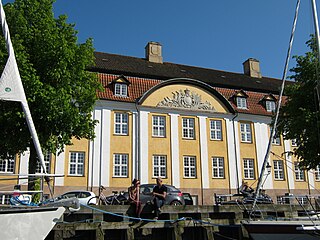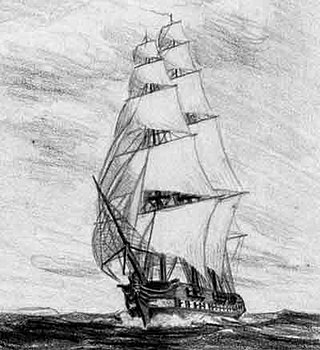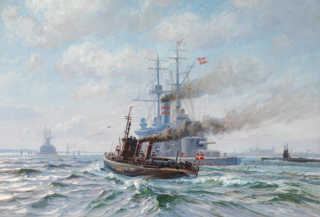
HDMS Sælen (S323) is one of the three Tumleren-class small coastal submarines of the Royal Danish Navy.

The Royal Danish Navy is the sea-based branch of the Danish Armed Forces force. The RDN is mainly responsible for maritime defence and maintaining the sovereignty of Danish territorial waters. Other tasks include surveillance, search and rescue, icebreaking, oil spill recovery and prevention as well as contributions to international tasks and forces.

Naval Station Holmen is one of several naval stations of the Royal Danish Navy, supplementing the two Danish naval bases in Frederikshavn and Korsør.
The 1982 Harpoon missile misfire incident, in Danish dubbed hovsa-missilet, was an unintentional discharge of a live Harpoon missile by Danish frigate HDMS Peder Skram during a training maneuver in the Kattegat on 6 September 1982. The missile traveled 34 kilometers at low altitude, severing several power lines before eventually striking a group of trees and exploding. The fireball and subsequent shockwave destroyed four nearby unoccupied summer cottages and caused minor damage to a further 130 buildings in the area. There were no injuries.

The Peder Skram-class frigate was a class of frigates built for the Royal Danish Navy in the period 1964–1967. Only two vessels in this class were ever constructed, Peder Skram (F352) and Herluf Trolle (F353). The ships were named after Danish admirals Peder Skram and Herluf Trolle

Holmen is a water-bound neighbourhood in Copenhagen, Denmark, occupying the former grounds of the Royal Naval Base and Dockyards. In spite of its name, deceptively in singular, Holmen is a congregation of small islands, forming a north-eastern extension of Christianshavn between Zealand and the northern tip of Amager.

Mastekranen is an 18th-century masting sheer and present landmark on Holmen in Copenhagen, Denmark. It was designed by architect Philip de Lange and built in 1748–51 as part of the Royal Naval Shipyard at Holmen.

The Danish ironclad Peder Skram was originally laid down as a wooden steam frigate for the Royal Danish Navy, but was converted to an armored frigate while under construction in the early 1860s. She had an uneventful career before she was stricken from the Navy List on 7 December 1885. The ship was converted into an accommodation ship that year and was broken up in 1897.

The Herluf Trolle class was a class of coastal defence ships of the Royal Danish Navy. The class comprised Herluf Trolle, Olfert Fischer and Peder Skram.

The Royal Danish Naval Museum is a museum dedicated to the history of the Royal Danish Navy. The displays include a collection of naval models which dates back to late 17th century. The museum is based in Søkvæsthuset, a former naval hospice which overlooks Christianshavn Canal.

HDMS Sehested was a Willemoes-class fast attack craft of the Royal Danish Navy which was in commission from 1978 until 2000. It is now docked at Holmen in Copenhagen where it serves as a museum ship, part of the Royal Danish Naval Museum. The ship is named after Christen Thomesen Sehested, a Danish vice-admiral during the Great Northern War (1709-1721).

HDMS Niels Juel was a training ship built for the Royal Danish Navy between 1914 and 1923. Originally designed before World War I as a monitor, construction was slowed by the war and she was redesigned as a training cruiser. Completed in 1923 she made training cruises to the Black and Mediterranean Seas, South America and numerous shorter visits to ports in northern Europe. The ship often served as a flagship and occasionally was used as a royal yacht for visits to overseas possessions and other countries.

HDMS Prinds Christian Frederik was a ship of the line in the Royal Dano-Norwegian Navy.

HDMS Bellona was a frigate of the Royal Danish Navy, which she served from 1835 to 1862.

HDMS Herluf Trolle (F353) was a Peder Skram-class frigate in the Royal Danish Navy which was in use until 1990. The ship is named after Herluf Trolle, a 15th-century Danish admiral.

HDMS Rota was a frigate of the Royal Danish Navy. She is above all remembered for being the ship that, in 1838, picked up the sculptor Bertel Thorvaldsen and many of his artworks in Livorno and brought them back to Denmark. Hans Dahlerup, her captain, and Alexander Wilde, then a junior lieutenant, have both described the voyage in their memoirs. In 1863, Rota was sold to H. Puggaard & Co. and converted into a civilian merchant ship. She wrecked off the coast of southern Norway in 1892, some ten years after being sold to Paul Larsen, Arendal.

HDMS Thetis was a frigate of the Royal Danish Navy, which she served from 1842 to 1864. She is best known for being one of the ships that picked up some of the sculptor Bertel Thorvaldsen's artworks and other belongings in Rome, some forty years after another Danish naval vessel by the same name had transported him the other way. In the meantime he had achieved international fame for his Neoclassical sculptures. Thorvaldsen, who had been back in Rome since September 1841, after moving back to Copenhagen in 1838, was also supposed to return with the ship. He did however, miss its departure by one day. The Royal Danish Navy's first music corps played its first performance on board the Thetis in 1857.

HDMS Olfert Fischer was the second member of the Herluf Trolle class of coastal defense ships built for the Royal Danish Navy. The Herluf Trolle class was built in response to a naval construction program in neighboring Imperial Germany. The Danish ships were built in the late 1890s and early 1900s. They were armed with a main battery of two 240 mm (9.4 in) guns and were capable of a top speed of 15.5 knots. Because she was intended to operate as part of a solely defensive naval strategy, Olfert Fischer had a fairly uneventful career. She visited Britain in 1911 to represent Denmark at the coronation of George V and Mary. During World War I, Denmark remained neutral and Olfert Fischer was assigned to the defense forces that guarded Danish territorial waters. Sharply reduced naval budgets in the 1920s and 1930s curtailed further activities, and Olfert Fischer saw little activity during this period, apart from testing a reconnaissance aircraft in 1922. She was eventually converted into a target ship and used for tests of aerial bombing of a ship underway in October 1936, before being sold for scrap immediately thereafter.

HDMS Peder Skram was the third and final member of the Herluf Trolle class of coastal defense ships built for the Royal Danish Navy. The Herluf Trolle class was built in response to a naval construction program in neighboring Imperial Germany. The Danish ships were built in the late 1890s and early 1900s; Peder Skram was delayed significantly compared to her sisters, and was laid down in 1905, after her two sister ships had already been completed. The ships were armed with a main battery of two 240 mm (9.4 in) guns and were capable of a top speed of 15.5 knots.
At least three ships of the Royal Danish Navy have been named Peder Skram:
























